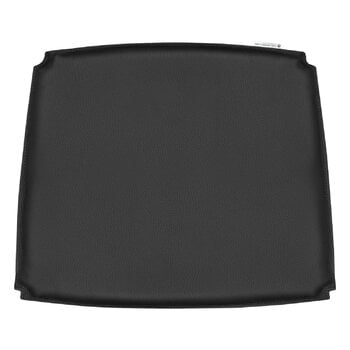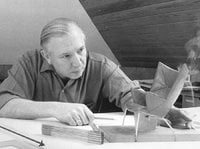Carl Hansen & Søn’s CH26 seat cushion is designed for Hans J. Wegner’s CH26 chair. Upholstered in high-quality leather and filled with High Resilience foam, the seat cushion adds a soft, luxurious touch to the wooden dining chair. The leather seat will develop a lovely patina over time and use.
CH26 cushion, black leather Loke 7150
Carl Hansen & Søn
Description
Carl Hansen & Søn’s CH26 seat cushion is designed for Hans J. Wegner’s CH26 chair. Upholstered in high-quality leather and filled with High Resilience foam, the seat cushion adds a soft, luxurious touch to the wooden dining chair. The leather seat will develop a lovely patina over time and use.
Product details (7)
- Material
- Leather, HR foam
- Colour
- Black
- Width
- 51 cm
- Depth
- 42 cm
- Height
- 3 cm
- Weight
- 0.77 kg
- Notes
- Please note that genuine leather is a natural product. This means that the colour and texture may vary from product to product.
- Product ID
Designer
Hans J. Wegner (1914–2007) is a world-famous Danish designer known especially for his numerous chair designs. Wegner had a special ability to combine functionality and aesthetics; many of his designs are characterized by playful or poetic features.
Born in Tønder, southern Denmark, Wegner developed a fascination for wood as a material already as a child: he enjoyed wood carving and often spent time in museums, looking for inspiration for his sculptures, and he even took up an apprenticeship with master cabinetmaker H. F. Stahlberg at a young age. Although Wegner began his career as a carpenter in the 1930s, in 1936 he decided to study design – a decision the modern design world is very happy for. Wood remained Wegner's favourite material throughout his prolific career, and most of his chairs are made of wood with the natural material often playing the main role in the design.
Wegner considered ergonomics to be one of the most essential aspects of designing a chair – after all, it was a piece of furniture with which the human body could be in contact for long periods of time. During his career spanning several decades, Wegner designed up to 500 different chair models, many of which have become coveted design classics not only due to their beautiful design but also their superb functionality. Perhaps the most famous of his design is the Wishbone chair, which has been in continuous production since 1950.
Wegner is known as one of the pioneers of Danish modernism and one of the key figures of the Golden Age of Nordic design. During his career, he received a multitude of design awards, including the Lunning Prize as well as the Grand Prix in the Milan Triennale in 1951, the Prince Eugen Medal in 1961 and the C. F. Hansen Medal in 1980.
Would you like to read more about Hans J. Wegner and his work? Discover our books:
Wegner: Just One Good Chair
Reviews (0)
Sustainability
The Product Sustainability Framework, our criteria of sustainable design, helps you find the most sustainable products in our selection. Read below which sustainability criteria this product has met.
Working conditions & labour 8/9
-
Equal opportunities for all employees
-
Commitment to UN Global Compact, fair compensation for all employees
-
Corporate responsibility requirements defined and communicated for suppliers
-
Systematic work for improved inclusion and well-being in the workplace
-
Transparent supply chain
-
Suppliers' compliance to a code of conduct ensured
-
Compliance to the UN Guiding Principles on Business and Human Rights ensured in the supply chain
-
Support for community involvement in the supply chain
-
Direct suppliers audited and certified
Eco-friendly production 7/9
-
Fair and resource-wise water-use in production
-
No incineration or landfilling of returned items
-
No use of endangered species as materials
-
No direct environmental emissions or waste (excl. GHGs) from production
-
The sustainability of direct suppliers' production is addressed and monitored
-
Material-efficient and ecological packaging
-
No potentially harmful chemicals used in own production
-
Production and material sourcing that respect biodiversity, animal rights, and natural ecosystems
-
Positive impact on nature’s well-being through operations that regenerate natural ecosystems
Climate impact 6/8
-
Company's direct greenhouse gas emissions identified and commitment to reduction
-
Product's carbon impact identified and commitment to reduction
-
Guidance on energy- and eco-efficient use of the product
-
Contribution to climate initiatives beyond the brand’s direct operations
-
Low-carbon or compensated transportation
-
100 % renewable energy in own production and operations
-
Carbon footprint of the product calculated and goals set to reduce it
-
Carbon neutral or carbon negative product
Sustainable materials 6/6
-
Sustainable and long-lasting material choices
-
No harmful or hazardous substances
-
Responsible raw material sourcing and production
-
Materials suited for circularity: monomaterials, recyclable finishings, renewable or recycled contents etc.
-
Ecological materials: natural, biodegradable, recyclable or recycled contents
-
Outstanding materials in terms of innovativeness, responsibility, sustainability and circularity: local production or sourcing, 100 % recycled content, C2C-certification etc.
Circular design 5/5
-
High aesthetic quality promoting long-term use of the product
-
Technically durable product design and material choices
-
Design for enduring life-long quality
-
Design and support for product maintenance, repair and upgradability
-
Innovative circular design solutions: circular service system, resale platform, remanufacturing, collection of used products, etc.




